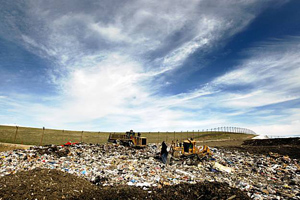February 22, 2010
What A Waste: Restricting “Non-Local” Garbage Is Bad For Everyone

By Michael D. Shaw
You may never have heard of Measure E, passed in Solano County, California in 1984. Solano County is located approximately halfway between San Francisco and Sacramento.
In effect, the measure would prevent waste from other jurisdictions from being disposed of in this county. However, inasmuch as the law attempts to discriminate against out-of-county waste—in clear violation of the Commerce Clause—county officials have never enforced it. The unconstitutionality of the provision was confirmed by the Legislative Counsel of California in 1992.
Measure E is another classic myopic NIMBY (Not in My Backyard) action, in which so-called environmentalists show little concern for the regional environment. After all, a goodly amount of the “foreign” waste comes from the San Francisco Bay Area—famous for doing all it can to protect the environment, but simply not having anywhere to construct its “own” landfill. Whatever happened to “Think globally, act locally”?
At the center of the controversy is the Potrero Hills Landfill in Suisun City. For five years, the expansion of this facility has been tied up in litigation, and one of the tactics was to invoke good old Measure E. As a result, a coalition of 23 waste hauling and recycling companies filed a lawsuit in federal court in September, 2009 seeking to finally declare Measure E unconstitutional. A few weeks later, California attorney general Jerry Brown filed a friend of the court brief arguing that Measure E was unconstitutional and that its enforcement would harm competition in the industry.
According to Ron Mittelstaedt, Chief Executive Officer and Chairman of Waste Connections, Inc., one of the plaintiffs, “Measure E threatens the future of safe, efficient and environmentally sound management of regional municipal solid waste. The consequences for Solano County taxpayers could include an annual loss of over $3 million to fund vital local services such as public safety, local road maintenance, and environmental compliance.”
Need we mention that jobs—green jobs—would be created in a state and county where unemployment hovers at around 12 percent?
There are also various related cases pending in state courts, but proponents of the expansion see a light at the end of the tunnel. Last November, Solano Superior Court Judge Paul Beeman decided to accept a county-approved environmental impact report (EIR). “When the court certified the EIR, that was the definitive ruling that other agencies were looking for to proceed,” said Jim Dunbar of Potrero Hills Landfill.
Thus, expansion of the site is underway. A further decision from Judge Beeman is expected shortly.
As often happens, the self-proclaimed environmental groups attempting to block the expansion are simply behind the curve. Anaerobic bacteria convert organic materials in the waste to methane—a large component of the aptly-named landfill gas, a renewable energy source. In the case of Waste Management—the leading provider of comprehensive waste and environmental services in North America—their landfill gas-to-energy projects generate enough energy to power 400,000 homes every day.
True ecology examines the relationships between an organism and its environment, and this of course includes humans and their environment. Isn’t it time that we move beyond primitive knee-jerk “environmentalism,” and produce solutions that benefit both people and the planet?
As some observers have said: Measure E deserves an “F.”

